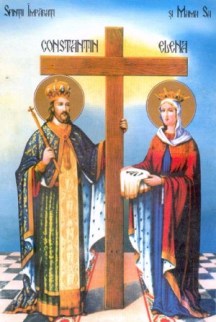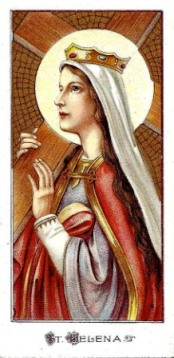The Invention of the Holy Cross (II)

In the previous article on the Invention of the Holy Cross awe saw some legendary historical references about the event. Now briefly discuss, cause summarizing nearly two millennia of history and devotion in a small, insignificant blog would, be too much to ask:
The first and most significant hurdles facing the "Invention" is that Eusebius, who lived at the time the cross was found and that, indeed, tells us about the expedition of Helena to the Holy Land in his "Life of Constantine” , does not mention the finding of the cross! It is unthinkable that an event like that was not recorded by him, having narrated the construction of a church in Bethlehem and one in the mountain of the Ascension at the hands of Helena. And further: in 335, Eusebius is present at the dedication of the church of the Anastasis (Resurrection), tells the whole ceremony and described the place, but makes no mention of the Cross.
To make matters worse, there is the original manuscript of an anonymous pilgrim of Bordeaux, who visit the holy places in 333. Describe the relics venerated as the bloodstain of Saint Zaccaria in his martyrdom, the column where Christ was scourged, to a palm branches which were pulled on Sunday when Christ entered Jerusalem, etc. But it doesn’t say a word about hpoly cross, so it must be concluded by this year, still not aware of that relic. If Constantine died in 337, the discovery had to have occurred between the 335 (Eusebio date) and the 337, but it happens that Helena’s journey to Jerusalem took place between 326 and 327.
Therefore, it was back to them when this cross (false or not is impossible to determine) was discovered and revered, and in 345, as evidenced by St. Cyril when he was a priest, who mentioned the presence of the Cross in his catechesis though without naming Santa Helena. Only confirms the existence and knowledge of the Vera Cruz, which is something. And I must remind you that around the year 351, it is mentioned again in a letter to Constantius, but if the cross had been brought to Rome by Helena and Constantine himself, no sense that Cyril mentioned the presence of the cross at Jerusalem to a son of Constantine, Constantine and Rome as whole would have refused.
Egeria, the great pilgrimage V century, tells the liturgy of the Church of the Holy Sepulchre, and crafts around "the cross", but it is unclear if it refers to the cross of Christ.
And on the subsequent history, the Basilica of the Holy Cross in Rome, where he allegedly kept the Cross and the title has already been written a lot and everywhere you can find out more, view photos, etc. For example, here in this video. My intention was to put the sources, historical and legendary. But i would not like to end this without some:
Considerations on the Cross:
Knowing a little history and customs, both Roman and Jewish, one can say with some certainty that the cross of Christ is completely unknown. The crosses were instruments used over and over again. Christ was crucified on a cross used many times before and after him. One more. It is inconceivable that the apostles or disciples collect and hide, knowing as the Jews’ aversion to blood. The apostles came from the Jewish world and we should not presume a particular devotion to the instrument of the martyrdom of his master.
On the other hand, the vertical beam used to be nailed, for practical reasons at the site of torture, the accused only had the tree section. So it would be even more difficult than the two beams remain together, when they should be used on multiple occasions and not always both a cross form.
Nails, like any instrument, were highly prized, as also used repeatedly edges and sharpen them as often as necessary and could be used. And since iron is thought to be many times. And most of the nails, presence and sites of worship, as in the third article.
By Ramon Rabre (text) and Marco Antonio Martinez Ruvalcaba (translation)
